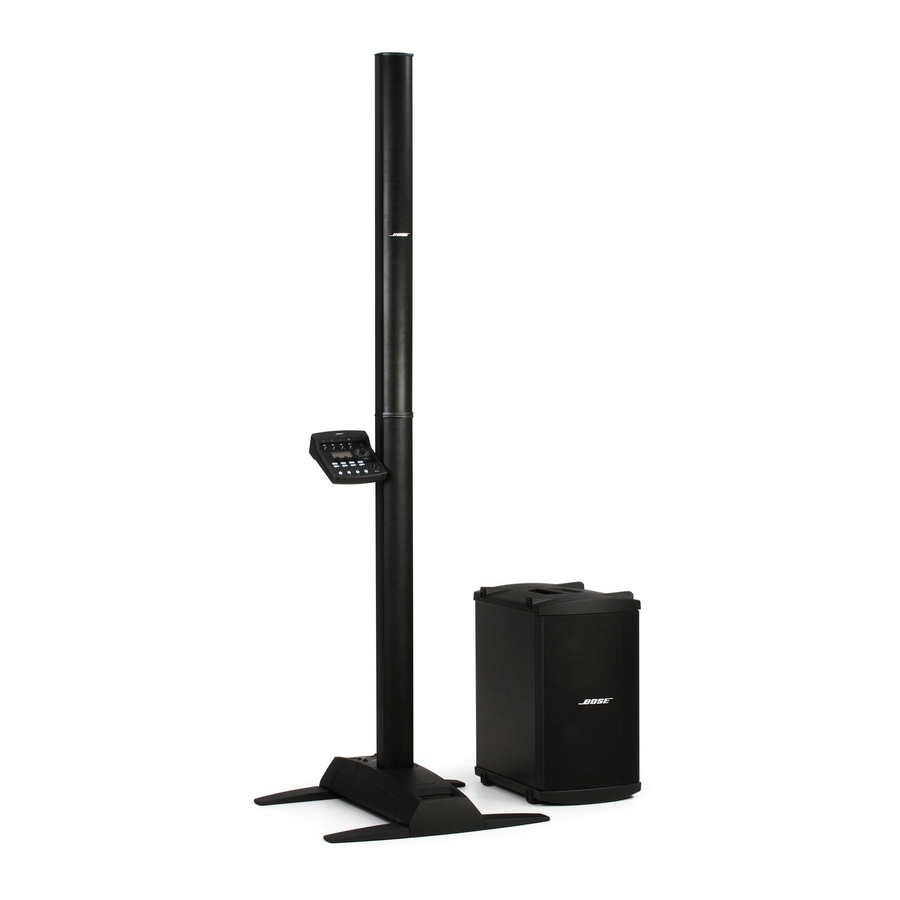Bose L1 Model II Manuel du propriétaire - Page 28
Parcourez en ligne ou téléchargez le pdf Manuel du propriétaire pour {nom_de_la_catégorie} Bose L1 Model II. Bose L1 Model II 32 pages. Portable line array systems
Également pour Bose L1 Model II : Manuel du propriétaire (32 pages), Manuel du propriétaire (28 pages), Fiche technique (8 pages), Fiche technique (8 pages), Manuel d'application (13 pages), Manuel (15 pages)

Svenska
Nederlands
C
M
ARE AND
AINTENANCE
Problem
With nothing plugged into
the power stand, a slight
hum or buzz is heard
B1 bass module is plugged
in, but no bass audio is
heard
B1 bass module sounds
out of balance with the
system
No mid/high sounds heard
TM
from the L1
model II
®
Cylindrical Radiator
loudspeaker
Instrument or audio source
sounds distorted
Third-party-powered sub-
woofer sounds poor when
connected to the Bass -
Line Out connector on the
power stand
B1 bass modules powered
by a third-party power
amplifier and connected to
the Bass - Line Out
connector sounds poor
Microphone is
encountering feedback
20
Italiano
Français
Svenska
What to do
• Using an AC outlet tester, test the AC outlet that the power stand is plugged into for
reversed or open (hot, neutral, and/or ground) contacts.
• If using an extension cord, make sure that the cord is also tested as above.
• Make sure you are using the included 4-wire B1 bass module cable.
• Make sure the B1 bass module cable is plugged into the Bass Module Out connector
and the cable plug is fully engaged in the connector.
• Try a different 4-wire cable.
• If available, try a different B1 bass module.
• Make sure you are using the B1 bass module 4-wire cable included with the B1 bass
module package.
• Make sure that the B1 bass module grille is facing forward toward the musicians and
audience.
• Make sure the L1 model II Cylindrical Radiator
seated in their connectors.
• Make sure connections are not bent or broken.
• Try cleaning the contacts on the loudspeaker top and bottom with electronic contact
spray cleaner.
• Make sure the Signal/Clip LED is not constantly red. If it is, lower the trim level.
• Try a different source or instrument.
• Try your source or instrument on another power stand.
• Unplug any B1 bass modules that may be connected to the power stand.
• The signal from the Bass - Line Out may be too high for the powered subwoofer; try
attenuating the signal using commercially available direct boxes or in-line pad devices.
• Try different connections to the third-party-powered subwoofer, such as balanced or
unbalanced cabling and/or a direct box.
• Check that the gain and input controls on the third-party-powered subwoofer are set
appropriately.
• If using a powered subwoofer with an adjustable crossover, set the crossover to 180Hz.
• Ensure that at least two B1 bass modules are directly connected to the Bass Module
Out connector on the power stand using a B1 bass module 4-wire cable.
• Check the gain settings on the third-party power amplifier. The volume level of the B1
bass modules powered by the power stand should be similar to the bass modules pow-
ered by the external amplifier.
• Orient the microphone so that it is not pointing directly at its respective L1 model II
®
Cylindrical Radiator
• Try a different microphone.
• Try a different position for the loudspeaker and/or vocalist on stage.
• Increase the distance from the loudspeaker to themicrophone.
• If using a vocal effects processor, make sure it is not contributing to the feedback
problem.
Nederlands
Español
loudspeaker.
Français
Deutsch
Italiano
Deutsch
Español
Dansk
®
loudspeaker top and bottom are firmly
English
English
Dansk
